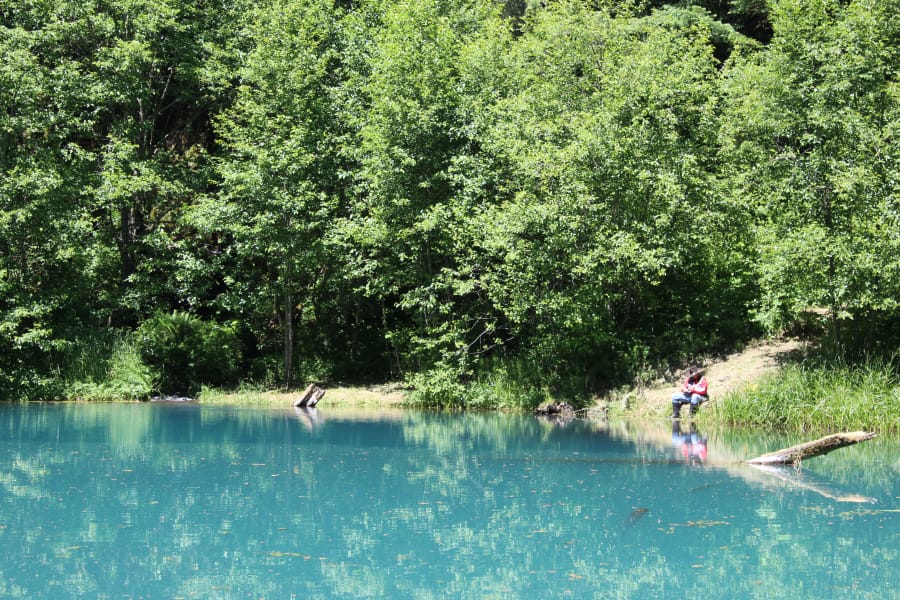Right below us was a deep sinkhole surrounded by brush and reed canary grass, and filled with cold water with a powder blue cast to it. We knew the hole held trout. I had been here before.
Getting down proved difficult. The steep, brush-filled hillside dropped precipitously to the water. We could see thick blackberry vines and stinging nettles as well as poison oak clustered thickly on the steep embankment.
We eventually found our way down a less steep grade where fir trees shaded out the heavy brush. The small pond held plenty of cutthroat trout, which were quite willing to hit small lures.
My fellow brush-buster, Buzz Ramsey of Yakima Bait, was getting the fish to strike a small spinner while I was having luck with a silver Kastmaster spoon.
After the fish grew wary of the hardware Ramsey started to offer them Berkley Trout Worms rigged about 2 feet below a split shot. Both natural colored and orange worms drew strikes.
Most of the trout were small, but they were beautiful specimens of pure cutthroat. Heavy spotting and wonderful colors along their sides made them very handsome fish indeed.
We eventually moved to another hole, this one slightly larger. The cutthroats were just as generous and we began to catch a few brook trout, too.
We never saw a sign of other fishermen. There were no rolls of discarded line, no bobbers hanging in the trees, no old bait cartons. These were untouched waters, and uneducated trout.
No wonder they struck with such abandon.
The sinkholes we were fishing are all linked together by Collins Creek in the area known as the Collins Landslide, on the Washington side of the Columbia River Gorge. This pre-historic landslide lies between Wind and Dog mountains near the town of Home Valley.
The slide is not currently active but has the potential to move at any time, something it has done in the recent past. As late as the middle of the last century it was necessary to continuously repair State Highway 14 and the railroad bed where they crossed the toe of the slide at Collins Point.
Every time the slide moved it buckled the road beds.
The reports describe a movement of as much as 30 to 50 feet per year that tapered off and stopped shortly after the mid-1970s.
Thomas A. Pierson, a recently retired research hydrologist for the United States Geological Survey, was the lead scientist on a study of landslides in the Columbia River Gorge on the Washington side. He explained how the slides can still become active.
“(There are) southward to southeastward dipping beds of 25-million-year-old volcanic sediments that have clay-rich weak zones within them,” said Pierson. “These weak zones become active failure planes when enough water percolates down to them during especially wet years, allowing old landslides to reactivate.”
Scott Burns is a Professor Emeritus at Portland State University. His area of expertise includes landslides, and he has been involved with many studies of slides within the Columbia River Gorge.
He explained that the slides originated with the prehistoric Missoula floods, which filled the Gorge with up to 1000 feet of water. These repeating flows started the sloughing off of material from the mountainsides.
He also spoke to the activity of the material piled on top of the sloping plates of ancient rock.
“Anything on top of that is going to slide,” said Burns. “It’s like a big conveyor belt. It could start moving again at any time.”
The result is a dynamic landscape that is tumbled and broken, with groundwater that percolates through the broken rubble. This creates lots of sinkholes and springs, and the creek and the connected pools are filled with water that stays very cold year-round.
Perfect for trout.
The groundwater also carries minerals and sediments, which may explain the blue color of the deep holes. The slide does not drain from any glaciers, although the color is reminiscent of glacial water.
In the center of the slide the ground has shifted and buckled. As the ground under the conifers shifts the trees shift also, creating sylvan groves that bend and curl in unison, as if in a choreographed dance.
The creek can also shift its location. In fact, it now flows about one half mile west of where most maps say it lies.
While we were happy with the numbers of trout we caught, it was proving difficult to catch the larger fish. I knew they were there since I had caught them before, but we landed just a few of the older trout all day.
As we hiked out I thought about the powerful natural forces that had sculpted this unique landscape. And, I knew I would be back again.
Accessing the landslide
Access to the slide is limited, given the nature of the terrain. There is access to Forest Service lands along Highway 14, and from Bergen Road. The primitive Cascades Crest Trail also runs along the northern part of the slide.
However, be warned that navigating the brushy country can be difficult. Hikers and sportsmen should carry a GPS or compass.
Be careful not to enter any posted private lands, and always check the regulations before fishing.




